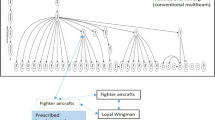Abstract
New and envisioned technological means and abilities for exerting command and control have increased the interest of man-machine research in a military context. Although there are many current proposals for how new command and control systems should be designed, many of the proposed properties that are considered advantageous have never been tested or could even be impossible to test in real-world situations. In spite of that, proposed design solutions are generally held valid in many Western countries where developments of major command and control system projects are in progress. An important question is how microworlds can be used for research on team decision-making. The use of microworlds gives us the possibility to create controlled settings and the opportunity to use advanced monitoring tools to study the subjects. Our studies indicate that the microworld concept, even though the simulation is fairly simple, reflects some of the crucial aspects of team-work in dynamic settings. The article presents results from a study in command and control using the C3Fire microworld (http://www.c3fire.org). Results and methodological issues are discussed.




Similar content being viewed by others
References
Alberts DS, Gartska JJ and Stein FP (2000) Network centric warfare: developing and leveraging information superiority. (2nd ed.) National Defense University Press, Washington, DC
Brehmer B, Sundin C (2000a) Command and control in network-centric warfare. In: Sundin C, Friman H (eds) Rolf 2010—the way ahead and the first step: a collection of research papers, Elanders Gotab, Stockholm, pp 45–54
Brehmer B, Sundin C (2000b) Joint and coalition command and control for the digitised battle space: a Swedish view. In: Sundin C, Friman H (eds) Rolf 2010—the way ahead and the first step: a collection of research papers, Elanders Gotab, Stockholm, pp 55–63
Castells M (2000a) End of a millennium. (2nd ed.) (vol. 3) Blackwell Publishers, Malden, MA
Castells M (2000b) The rise of the network society. (2nd ed.) (vol. 1) Blackwell Publishers, Malden, MA
Castells M (2001) The Internet galaxy: reflections on the Internet, business, and society. Oxford University Press, Oxford New York
Cebrowski AK, Garstka JJ (1998) Network-centric warfare: its origin and future. U.S. Nav Instit Proceed 124(1):28–35
Dörner D (1980) On the difficulties people have in dealing with complexity. Simul Games 11(1):87–106
Engeström Y (1987) Learning by expanding: an activity-theoretical approach to developmental research. Orienta-Konsultit Oy, Helsinki
Engeström Y, Middleton D (1998) Cognition and communication at work. Cambridge University Press, New York
Engeström Y, Miettinen R and Punamäki RL (1999) Perspectives on activity theory. Cambridge University Press, New York
Gardner H (1985) The mind's new science. Basic Books, New York
Goodwin C (1994) Professional vision. Amer Anthropol 96(3):606–633
Granlund R (2002) Monitoring distributed teamwork training. Dissertation, Linköping University, ISBN 91-7373-312-1
Granlund R, Johansson B, Persson M (2001) C3Fire— a microworld for collaboration training in the ROLF environment. In: Proceedings of the 42nd Conference on Simulation and Modelling, Simulation in Theory and Practice, Porsgrunn, Norway, 8–9 October, 2001
Granlund R, Johansson B (in press) Monitoring distributed collaboration in the C3Fire microworld. In: Schifflett SG, Elliot LR, Salas E and Coovert MD (eds) Scaled worlds: development, validation, and applications. Ashgate, Aldershot, UK
Heath C, Hindmarsh J (2000) Configuring action in objects: from mutual spaces to media spaces. Mind Cult Activ 7:81–104
Hollnagel E, Woods DD (1983) Cognitive systems engineering: new wine in new bottles. J Man-Mach Stud 18:583–600
Johansson B, Granlund R and Waern Y (2000) The communicative aspects of distributed dynamic decision making in the ROLF environment. In: Friman H (ed) Proceedings of the 5th International Conference on Naturalistic Decision Making, Tammsvik, Sweden, 26–28 May, 2000
Omodei MM, Wearing AJ and McLennan JP (2000) Relative efficacy of an open versus a restricted communication structure for command and control decision making: an experimental study. In: McCann C and Pigeau R (eds) The human in command: exploring the modern military experience, Plenum, New York
Sundin C, Friman H (eds) (1998). Rolf 2010—a mobile joint command and control concept. Elanders Gotab, Stockholm
Sundin C, Friman H (eds) (2000) Rolf 2010, the way ahead and the first step: a collection of research papers. Elanders Gotab, Stockholm
Wiener N (1965) Cybernetics: or control and communication in the animal and the machine. (2nd ed.) M.I.T. Press, Cambridge, MA
Author information
Authors and Affiliations
Corresponding authors
Rights and permissions
About this article
Cite this article
Johansson, B., Persson, M., Granlund, R. et al. C3Fire in command and control research. Cogn Tech Work 5, 191–196 (2003). https://doi.org/10.1007/s10111-003-0127-x
Published:
Issue Date:
DOI: https://doi.org/10.1007/s10111-003-0127-x




